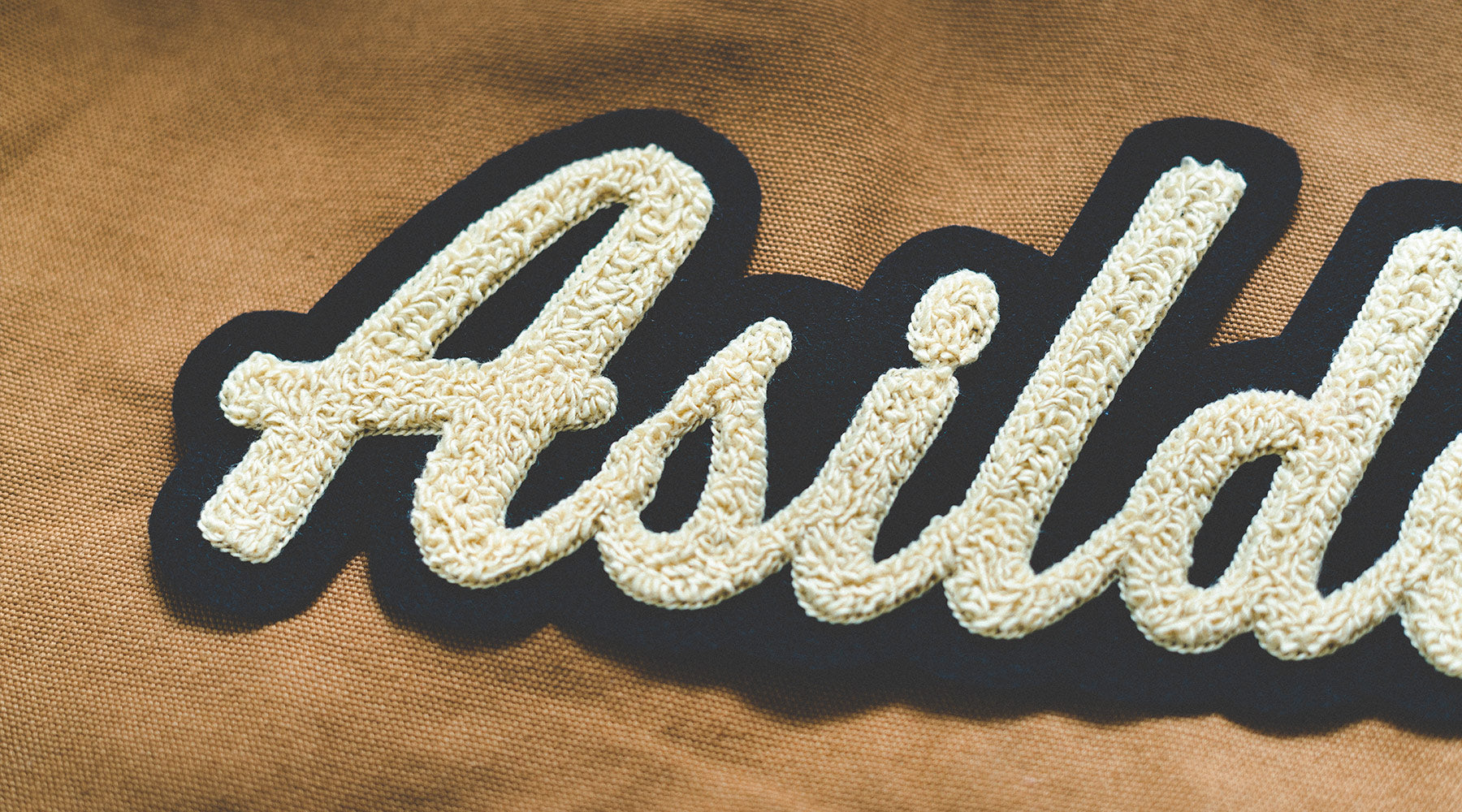Your Cart is Empty
Custom Chenille Jacket Patches

In America, most people probably know chenille best for its use to make the furry patches emblazoned on high school letterman jackets.
We don't see too many chenille patches on modern denim jackets, but with the rise in popularity of chain stitch patches, this may change soon. Chenille is a cost-friendly less customizable version of chain stitch patches, more on those in another article.
Typically indicators of sporting or other achievements, the bold patches have come to signify and display pride. But the textile actually has a varied history stretching across many countries as well as for varied uses.
Chenille is a soft and texture-rich fabric that uses silken threads sewn onto cotton or wool in tight loops (source). It has lot of uses in home decor, towels, and many other types of products, so it's likely you'll start noticing chenille being used in many places.
The Origins of Chenille
The name chenille actually comes from the French word for caterpillar, owing to the fuzzy nature of the material. Compared to some other types of textiles, the yarn used to make chenille is relatively recent and only goes back to the 1700’s. That may sound like a pretty long time until you consider that other threads such as wool date back more than 3500 years.
While the French were the first to create the particular type of yarn used in chenille, a foreman in a Scottish fabric mill, Alexander Buchanan, is regarded as being the first to introduce chenille fabric, which he used to weave fuzzy shawls. To achieve this, he took tufts of colored wool and wove them together into a blanket that was then cut into a series of strips. By then heating the strips with hot rollers this then created the soft and fuzzy texture the material is known for.
Later, two other people working in the shawl manufacturing industry, James Templeton and William Quiglay, pushed Alexander Buchanan’s ideas further. They were working on perfecting a process to create imitation oriental rugs. The intricate patterns that were the hallmark of the oriental rugs were notoriously slow and challenging to reproduce and they saw the chenille process as a potential way to solve their problems.
Mr. Templeton was a shawl manufacturer while Mr. Quiglay was a weaver. Operating as a joint venture the two men managed to gain a patent for weaving cords of chenille into carpets.
This not only solved their problem of how they could create the oriental patterned carpets but also led to a new technique for the mass production of soft and fuzzy shawls, mat, and bedspreads.
They could now manufacture tufted carpets by machine rather than by hand, matching the quality of hand-woven carpets in a fraction of the time.
William Quiglay later sold half of the patent to James who had grand plans for the new textile. In 1841, James gave the new fabric a royal touch when he manufactured the carpet for the baptism of the future British king, Edward VII. The carpet stood proudly in St. George's Chapel in Windsor Castle. Chenille had truly made its mark on the world.
The Letterman Jacket and Patches
The letterman jacket is an iconic part of American culture that started as a tradition in a single school but soon spread across the entire nation. Receiving the school letter that was placed on the jacket was a mark of pride handed out to athlete’s for first making it onto a sporting team or for individual excellence.
The jacket has come to represent school, team and individual pride and accomplishment. They serve as a way of showcasing personal sporting or academic achievements by way of the chenille patches, pins or badges.
The wool and leather sleeved jacket actually started out as a letterman sweater and was first worn by members of the 1965 Harvard University baseball team. A large “H” written in the Old English style was sewn onto the sweater. On those original sweaters, the letter was oversized and centered. Stripes down one sleeve would designate the number of letters won while a star on the sweater would indicate that the wearer was the team captain.
The jacket has come to represent school, team and individual pride and accomplishment. They serve as a way of showcasing personal sporting or academic achievements by way of the chenille patches, pins or badges.
The wool and leather sleeved jacket actually started out as a letterman sweater and was first worn by members of the 1965 Harvard University baseball team. A large “H” written in the Old English style was sewn onto the sweater. On those original sweaters, the letter was oversized and centered. Stripes down one sleeve would designate the number of letters won while a star on the sweater would indicate that the wearer was the team captain.
The Harvard football team also started to use the “H” on their uniform in 1875. Interestingly, for the first 25 years of using the letter, Harvard sports captains only allowed certain players who played in the team’s most important matches (usually those against either Princeton or Yale) to keep their “H” emblazoned uniforms. Otherwise, the players had to return their uniform at the end of the season.
Varsity letterman jackets didn’t really start gaining popularity until the early 1900’s and it was the introduction of the woolen jacket with leather sleeves in 1930 that saw their popularity really take off. Letterman jackets are usually adorned with stitched on chenille patches of the school’s mascot, school name, numerals of the year of graduation, or other awards.
 A modern letterman jacket with a chenille “M” patch. Source
A modern letterman jacket with a chenille “M” patch. Source
On letterman jackets, the chenille letter is traditionally placed on the left chest of the jacket, which can also be adorned with other championship chenille patches representing individual or team accomplishments. Chenille letters can come in many different shapes and styles. Some schools favor the single letter using the Old English style script, with others using two or three letters, 3D shading, chenille bordering, or straight block styles.
How a Teenager Started an Entire Industry
During the 1890’s chenille was rapidly becoming the main fabric used for carpets all over Europe. In America, it was also starting to become a trending fabric for use in home goods. Amazingly it was also all focused on one small town in northern Georgia.
In 1895, a 15-year-old named Catherine Evans took a keen interest in an old family heirloom quilt that was made using the old candlewicking embroidery process. Candlewicking involved using cotton thread on a piece of unbleached muslin. The name came from the nature of the softly spun cotton thread, which was also used at the time to be braided into candle wicks.
Candlewicking embroidery allowed for the creation of designs made using traditional stitching as well as tufted stitch.  Example ofcandlewicking embroidery. Source
Example ofcandlewicking embroidery. Source
Although long since out of style as a way of creating decorative quilts, Catherine was so taken by the rich quality of the quilt’s design that she began developing her own more efficient technique to create similarly beautiful designs.
Catherine’s technique involved sewing a coating of cotton cloth onto a base of cotton to create ornamental patterns. She would then shrink the fabric in boiling water so the yarn would stay in position and to create a fuzzy texture for the yarn.
This made it possible to create ornate bedspreads in a fraction of the time it would take to hand stitch every tuft as needs to be done using the original candlewicking technique.
The original quilt that Catherine created was displayed at the Prater's Mill Country Fair in Varnell and impressed many who saw it. These quilts rapidly became popular in her hometown of Dalton, Georgia, then in the local region and then nationally. Her family started producing the materials for many local ladies who began making a whole range of tufted designs that were marketed as chenille.
So popular was the new chenille process that tufting played a vital role in the economic development of the whole northwestern part of Georgia. As the chenille products grew in popularity, merchants across the Dalton region all began marketing the bedspreads. By the 1920’s tufted bedspreads were appearing in department stores in every major city across America.
Merchants began organizing an entire industry around the manufacture of the chenille spreads to fill the growing demand. Homes and then whole warehouses were established where tufters would sew in the patterns of designs onto sheets printed with different desired patterns.
Men called haulers would deliver the printed sheets en masse to thousands of rural homes across northern Georgia, Tennessee and the Carolinas, where they would be tufted and then the haulers would return to pick up the completed spreads for distribution.
Soon clotheslines all along Highway 41 through Dalton and other small towns across Georgia were filled with the tufted spreads and tourists would stop to buy them on their way through to Florida.
This section of the highway became known as “Peacock Alley” due to the popularity of a particular motif that was most commonly used on the spreads.
The income generated by the popularity of the chenille bedspreads for poor families in these rural areas became hugely important in helping them to weather the difficulties of the Great Depression.
By the late 1930’s Dalton had its first bedspread millionaire, B.J. Bandy, and he wasn’t the only one. Many others also earned their fortunes manufacturing the bedspreads and soon the process began to be turned over to industrialization in an attempt to keep up with the demand and to maximize profits.
The industrialization of the tufting process increased productivity and created an entire textile industry focused in Dalton.
The ongoing success of the tufted bedspreads led to the creation of other chenille products including bathrobes, small rugs, and even tank sets, which were fuzzy covers for toilets. The machine tufting process also allowed for the creation of room-sized carpets made from the raised yarn tufts.
Soon Dalton became not only the chenille bedspread capital of the world but by 1960 it was also the carpet capital of the world. Catherine Evans could never have imagined what an impact her homemade bedspread would have on the entire fortunes of her humble hometown. Even today, around 90% of the world’s wall-to-wall carpet is designed in and around Dalton.
Creating Modern Chenille
Rather than the older manufacturing technique that involved weaving, beating, cutting, and heating, the modern technique involves using piles of short lengths of yarn between two spinning core yarns. The piles can be of any fiber type so can include silk or rayon as well as the traditional choice of cotton.

A modern chenille bedspread. Source
Chenille is still incredibly popular today both as a material for making carpets, rugs, and bedspreads as well as for patches. It is also used as a popular furnishing fabric for upholstered furniture or for other home furnishings due to its appealing soft and fuzzy texture.
The following are some chenille patches that are available today, showing the variety and range of styles on offer.
Where to Buy Chenille Patches Today
When I looked around for places to order chenille patches from, I found lots of websites and a few that seemed like the most trustworthy options. I ordered my chenille patches from Neff (neffco.com) and Anything Chenille (anythingchenille.com). Neff states that 95% of high schools buy chenille patches to pass out as awards. Pretty cool. I didn't go to high school here and we had no awards really, so this seems pretty awesome.
There also were some chenille patch options on Etsy and eBay, but frankly pretty limited variety.
You can get names, states, sports, numbers, and anything custom. For me, there were a bit too many options and I just ordered a name patch with a tail. There are dozens of colors and combos you can create and I went with a gold/white/black color because everything else seemed overwhelming and I used one of the sample images as reference to just order the patch already.
A Note on Personalized Patches
If you're interested in buying personalized patches, chenille or not, I'm writing a comprehensive guide to different personalized patch types and places to order them. The article will be live in a few weeks, so stay tuned.
Also in Asilda Blog

Why I started Vlogging - My 3 Reasons
The first month of vlogging is done and now I get asked more and more about why I started all this, and especially right now. So here are my three reasons.
Read More
Cecilia Humboldt Camera Backpack Review
Join me in reviewing this Cecilia Humboldt 14L in Black Leather Camera Backpack I got to test out. The leather is buttery smooth and the bag is very enjoyable to use.
Read More
Neon Signs: A Symbol of America
When you think Americana, neon signs are always a big part of the visual. In this article, you'll find out about the history of neon signs...
Read More

 Original Harvard University “letter sweaters.”
Original Harvard University “letter sweaters.”  People creating tufted bedspreads during the Great Depression era.
People creating tufted bedspreads during the Great Depression era.